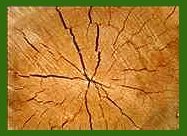Below are some of the terms which are often associated with the anatomy of wood. Remember that wood is the term used for the secondary xylem formed by the cambium of the tree. Two general terms which are also often used are hardwood and softwood. These are terms used in industry to refer to woods of different origins which have different properties.
(Take a look at a comparison of hard woods and softwoods.)
 |
|
A cross section though tree trunks showing growth rings
|
In trees which live in a seasonal climate the cambium is not active the whole time. During winter its cell walls are thickened and it is inactive. When the warmer days of spring arrive or the wet season arrives, the cambium is reactivated. Its cell walls become thinner and it starts to divide actively again. The xylem cells which are formed at the beginning of the season tend to be large and have thinner walls. This is called spring or early wood. As the growing season continues and conditions become less favorable (e.g. it may start to get hot and dry) the cambial activity slows down and the xylem which is now formed has smaller cells with thicker cell walls. This is called summer or late wood. The difference between early and late wood make it possible to discern concentric circles in a cross-section through the wood of a tree trunk or branch. These rings are know as growth rings. Each increment in size in the branch or trunk diameter can be observed in the growth rings which remain unchanged after they have formed.
Trees which grow in temperate regions with definite seasons, form one growth ring per year. The same is not true for all trees however, as some trees which come from arid or semi arid regions may form more than one growth ring, depending on the when the rains have fallen in a particular year. Trees from tropical climates which show less seasonal change, sometimes grow continuously and do not have any growth rings.
Because climate strongly influences the formation of the growth rings they may be used by scientists to gain a better understanding of the past climate of an area. The bristle-cone pine of California, which is very slow growing but very long lived, has been used to gain further insight into the Californian climate over the last 2000 years.
 |
|
A cross section through a tree trunk showing growth rings and how the wood has split along the rays. |
Rays are groups of cells in the wood which are orientated perpendicularly to the main axis of the stem, unlike the tracheids, vessels and fibres which are orientated parallel to the main axis of the stem. They are composed of ray paranchyma cells or sclerenchyma. They divide the stem into sections like the slices of a pie. Their function is to allow the transport of water and dissolved nutrients, radially across the stem.
Based on its position and function, wood of a tree may be divided into sapwood and heartwood.
Sapwood : is the outer few centimeters of the wood which border the cambium. This is the xylem which transports water and dissolved nutrients (sap) from the roots to the leaves. It is often light in colour and not as strong as the heartwood.
Heartwood : is the inner, older wood which in some large trees may be more than a metre in diameter. The tree uses the heartwood as a place to store waste products. Thus, as the tree matures, metabolites are deposited in the heartwood. These include resins, gums, oils and tannins which stop up the vessels and clog the wood. The heartwood is darker, denser, more durable and stronger than the sapwood and plays an important role in supporting the tree.
|
|
 |
Knots
Knots are the bases of branches which have been covered as the tree has grown laterally. They may fit either tightly or loosely into the stem. If the branch was dead when the trunk grew around it, there tends not to be any connection between the xylem of the knot and the trunk and the knot fits loosely and may fall out of the wood, leaving a knot hole. If the knot was alive when the trunk grew around it, the xylem of the trunk and the branch are continuous and the knot fits tightly into the wood. Many knots may decrease the value of the timber.
| Three section of wood with knots. The top section has a tightly fitting knot whereas the two sections below have loosely fitting knots. |